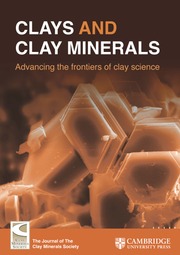Article contents
Comparative Computational Study of NP(V) and U(VI) Adsorption on (110) Edge Surfaces of Montmorillonite
Published online by Cambridge University Press: 01 January 2024
Abstract
Sorption of U(VI) on clay and related minerals has been inspected experimentally and computationally because of its central role in safety considerations of geological repositories for highly radioactive waste. Np(V), which also has long half-life isotopes, has received considerably less attention. The purpose of the present study was to investigate computationally the adsorption of Np(V) on a clay-mineral surface and to compare it to adsorption of U(VI). As a sample case study, adsorption of Np(V) at the (110) edge surface of the common clay mineral montmorillonite was modeled. The density functional approach and periodic supercell models were applied. Mono- and bidentate adsorption complexes with coordination numbers 4 and 5 were inspected and compared to corresponding U(VI) species. While U(VI) prefers bidentate adsorption complexes with varying coordination numbers, Np(V) is more stable when monodentate-coordinated with a coordination number of four. In line with its smaller hydrolysis constant in aqueous solution, Np(V) shows a lower tendency to form monohydroxides on the mineral surface compared to U(VI). As no experimental geometry parameters are available for Np(V) adsorbed on montmorillonite, the results were compared tentatively to EXAFS data for adsorption at kaolinite and good agreement for the geometry changes due to adsorption was found for the more preferred adsorbed species.
Keywords
Information
- Type
- Article
- Information
- Copyright
- Copyright © The Clay Minerals Society 2016
Footnotes
This paper is published as part of a special issue on the subject of ‘Computational Molecular Modeling.’ Some of the papers were presented during the 2015 Clay Minerals Society-Euroclay Conference held in Edinburgh, UK.
References
- 6
- Cited by

